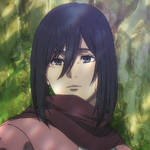- Manga
- Anime
The oriental clan (東洋の一族 Tōyō no ichizoku?) is a bloodline within the Walls originating from a land in the far east. They are one of the few clans immune to the Royal Family's power and were persecuted after betraying the monarchy.[3]
Story
The Struggle for Trost arc
During the Battle of Trost District, Mikasa Ackermann recalls the time from her childhood when her mother and father were killed by bandits who were hoping to sell her and her mother to potential buyers in the underground city. She is rescued by Eren Jaeger when he kills two of the traffickers and Mikasa herself kills the third after Eren urges her to fight. After the death of her mother, Mikasa becomes the last surviving member of the Oriental clan within the Walls. [4]
Members
Trivia
- In the manga, the oriental clan possesses a special tattoo-like brand passed down from generation to generation, which Mikasa receives from her mother shortly before her parents are murdered. In the anime and the visual novel, this brand is replaced with a unique stitching method.[5][4]
- Due to the etymology of Mikasa's name, it is likely that the oriental bloodline is based more specifically on the people of the Japanese islands, though Hajime Isayama has stated that the "East Sea" of the Attack on Titan world is different than the East Sea of the real world.[2]
References
- ↑ Attack on Titan ANSWERS
- ↑ 2.0 2.1 "Regarding the "Asian Clan" -Snk ANSWERS". suniuz.tumblr.com. — "Right now there is nothing I can fix since I’ve already drawn it in the manga, but the word Touyou is prone to confusions. In the world of the original work, it means “East Sea” and the kanji character 洋 takes its literal meaning which is the “ocean”. But if I say Touyou nowadays, people will for sure interpret it as Japan or Asian regions…… The Touyou in Snk world is different from the Touyou in our real world!".
- ↑ Attack on Titan anime: Episode 43
- ↑ 4.0 4.1 Attack on Titan anime: Episode 6
- ↑ Attack on Titan manga: Chapter 5 (p. 29)


